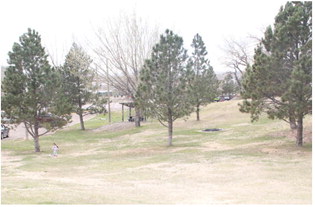Storms Hit Eastern Montana


A large upper level low pressure system off the West Coast created a series of events for three days across eastern Montana that led to severe weather with large hail and damaging winds as well as flash flooding.
June 8
The event started with thunderstorms kicking off north of I-94 in Dawson and Wibaux counties with storms moving in a northerly direction. The largest reports of hail were four inches in diameter, 9 miles east of Glendive, and baseball size hail (2.75”) 15 miles north of Wibaux. Numerous reports of quarter to golf ball size hail were received in Wibaux, Dawson, Richland and Roosevelt counties. As the storm moved north, downburst winds caused minor to moderate damage to buildings in the Fairview area and uprooted some large pine trees, and damaged large branches on other trees. Strong to severe thunderstorm winds of 55 to nearly 80 mph were reported.
Additional storms started forming in Garfield, Valley and Phillips counties, eventually extending into western Roosevelt County. Winds were in the 40 to 60 mph range with a report of golf ball size hail at the Hell Creek Marina in northern Garfield County.
Storms trained (followed the same path over and over) in western Roosevelt County, leading to flash flooding as water came up and over U.S. Highway 2 about 5 miles west of Wolf Point as well as Highway 13 North of Wolf Point. Some individuals said they had never seen water that high in more than 50-85 years of being in the region. Rainfall estimates and spotter reports indicated the totals were 3 to 6 inches in under 90 minutes. Although the area is in a D2/D3 moderate to extreme drought, the soils could not handle that much water in a short time. Reports also indicated that low water crossing in sparsely populated areas of northern McCone County also had excessive rainfall.
The two biggest impacts on this day were the hail in Dawson and Wibaux counties and the flash flooding in western Roosevelt County over highways.
June 9
A supercell thunderstorm formed in central Montana and built over the Little Rocky Mountains along Blaine and Phillips counties and a portion of the Fort Belknap Reservation. This was one storm, and was the only storm in the region, so it was well documented by storm chasers. The hail was anywhere from quarter size (1”) up to 3” in diameter in the Zortman area. Impacts were minimal due to the rural nature of this storm.
June 10
This event was the most significant of the three days. Warm, moist air had been building in eastern Montana and a cold front was coming in from the west. Thunderstorms started forming in the Yellowstone River Valley from Wibaux to Sidney and then moving in a north and northeast direction into North Dakota. The storms had rotation in them, triggering tornado warnings along the Montana and North Dakota border numerous times. As far as could be ascertained from reports from storm chasers, weather spotters, the public and DES coordinators, the first actual tornado most likely actually occurred in North Dakota, but could easily be seen from Montana. No reports of damage were received from tornadoes in Montana or North Dakota.
Further north, storms moved into northern Roosevelt, Daniels and Sheridan counties. Some isolated damage occurred from what on video looks to be a gustnado. In reviewing the radar data, there were no storms in the Flaxville area when this damage occurred.
To the west, thunderstorms starting in south-central and central Montana drifted northward.
While they initially weren’t very significant, as they moved northeastward, they moved into more unstable air, and a cold front coming in from the west helped cause them to increase in intensity by early evening. These storms moved across northwest Prairie County all the way through the Sidney/ Fairview and Bainville areas several hours later. They had hail as large as three inches in diameter and winds from 70 to 90 mph measured, with a damage survey showing support for up to 115 mph in the area about 6 miles northwest of Sidney. This caused damage to homes and buildings, took down 75-year-old spruce trees, and snapped approximately 1,000 power poles in Terry, McCone, Dawson, Prairie and Williams counties. These poles were owned by either McCone Electric, Lower Yellowstone Rural Electric or DOE/Western Area Power Administration.



